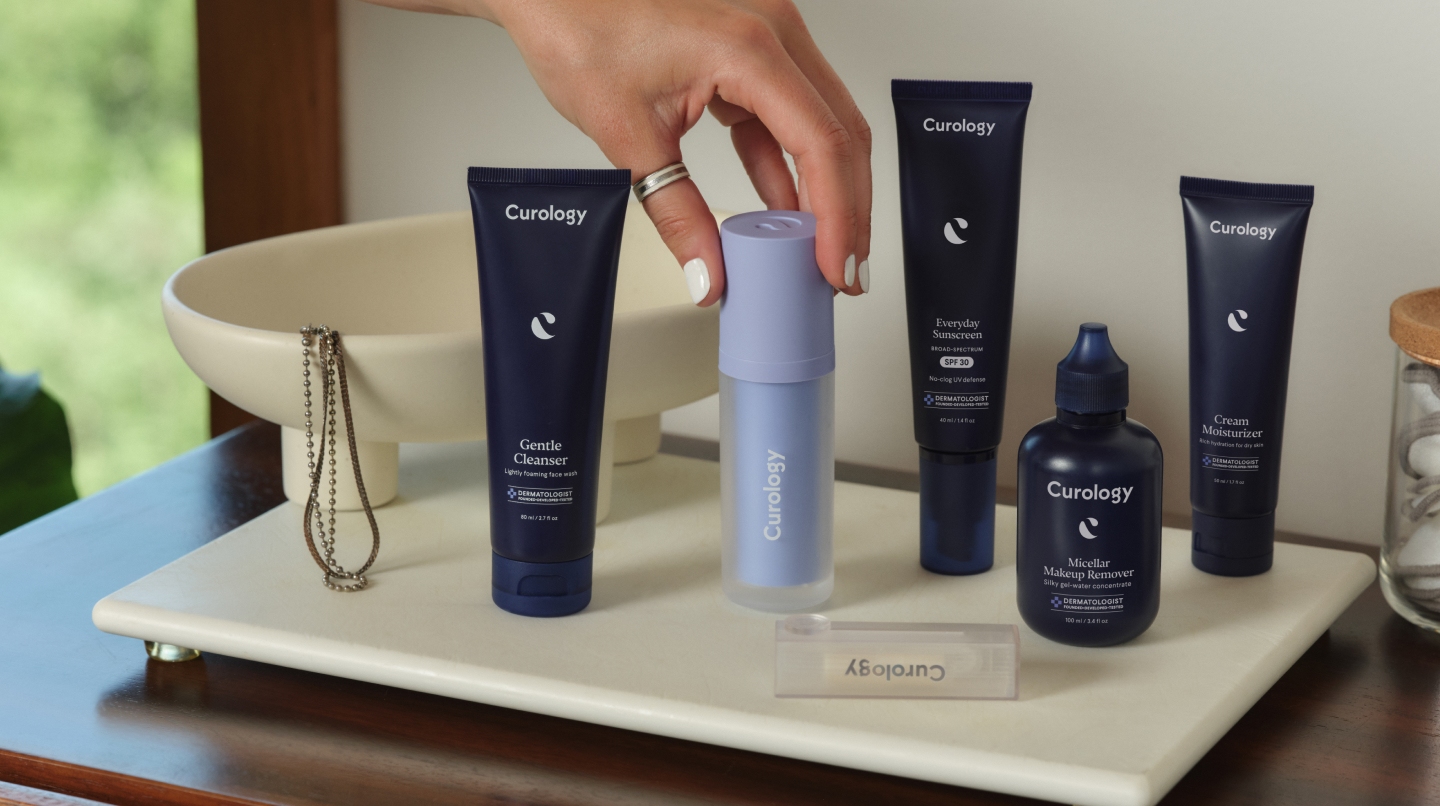How it works:
Share your skin goals and snap selfies
Your dermatology provider prescribes your formula
Apply nightly for happy, healthy skin
How it works:
How it works:
Share your skin goals and snap selfies
Your dermatology provider prescribes your formula
Apply nightly for happy, healthy skin
How it works:
Expert-approved tips to help you control oily skin
Curology’s dermatology providers share their advice for taking care of acne-prone skin



Oily skin can happen when your sebaceous glands produce too much sebum, the oily, waxy substance that protects and hydrates the skin. It plays an essential role in keeping skin healthy, but too much of it can contribute to clogged pores and other types of acne.
Sound familiar? If so, and you’re wondering how to stop having an oily face during the day, you’re in luck. While you can’t change your skin type, there are things you can do to help keep that shine under control. If you have oily skin, step one is dedicating yourself to a specialized skincare routine. Here we’ll offer tips from our experts on how to control face oiliness and share some of our favorite oil-reducing products.
What causes oily skin?
First off, exactly what is oily skin? In short, it’s the result of the skin’s sebaceous glands producing excess sebum.¹ Its symptoms and severity can vary from person to person (in other words, some people’s skin is simply oiler than others). Many people with oily skin experience a shiny appearance as well as blackheads, breakouts, and larger-looking pores. Oily skin is primarily due to genetics, but other factors can also contribute to oiliness. For example, people tend to be more oily when it’s hot and humid outside. Stress levels and hormone changes can also affect how much sebum your body produces.
How to manage face oiliness
While you can’t completely prevent oily skin, you can learn to manage it. From lifestyle changes to your skincare routine, there are many ways to help control facial oiliness. Our favorite ways to cut down on shine include the following:
Avoid overcleansing
To help control oil production, it’s important to cleanse your skin correctly, and that includes, believe it or not, taking steps to help keep it hydrated (more on that in a bit). Use a gentle cleanser that removes dirt and debris without damaging your skin’s natural barrier function and moisture levels. You can also try a cleanser with a beta hydroxy acid (BHA), such as salicylic acid, that will help dissolve excess oil. Salicylic acid is a powerhouse ingredient for fighting face oiliness, and it’s also lipophilic, meaning it’s attracted to and helps break down excess sebum or oil. It helps clear out pores and is anti-inflammatory, which can also help fight the breakouts that often accompany oily skin.
Keep moisturizing
If you have oily skin, you don’t necessarily need to avoid moisturizing—that’s a skincare myth! In fact, skin can be oily and dehydrated simultaneously, and hydrating products are important for all skin types and skincare routines. Moisturizer helps your skin maintain its natural moisture (hence the name), but choosing the right one for your skin is important. If you have oily skin and are concerned about breakouts and blackheads, consider lighter options instead of heavier, thicker varieties. And on that note…
Consider your products carefully
Some products that say they’re specially formulated for oily skin can actually contain overly harsh ingredients. These can do more harm than good. Those that contain alcohols and astringents can remove excess oil successfully in the short term but, over time, may trigger irritation. They may also disrupt your skin’s barrier, leaving it potentially inflamed, dry, and sensitive. If a product makes your skin feel dry and tight, it’s probably best to stop using it.
Reduce stress
Stress releases hormones that can stimulate your oil glands, which can increase sebum in your skin. Reducing your stress level through self-care activities like exercise, meditation, yoga, walking, and your favorite hobbies may help to reduce your skin’s sebum production. Plus, they’re fun and relaxing!
Size up your diet
Did you know sugar and dairy may be culprits of oily skin for some people?² These substances can increase oil production in some individuals, and reducing or cutting out your intake can have surprising results for your skin. If you’re curious, try reducing your sugar and dairy intake for a few weeks to see if it affects the oiliness of your skin.

More oily skin tips from Curology’s experts
We took our oily skin questions to the experts, Curology’s Jake Swanson, a physician assistant, and Meredith Hartle, a board-certified physician!
When it comes to treating oily skin, Jake recommends zinc soap, as topical zinc may reduce oil production,³ leading to a decrease in oiliness and breakouts. As far as skincare routines for oily types go: “Less is best. Listen to your skin and try to give it what it needs, such as skipping the moisturizer on days you don’t feel you need it,” says Jake. “Some oily skin does need moisturizer, as it can be the result of the body’s natural response to dryness.”
Meredith is all about a simple, consistent skincare routine that suits your skin’s needs. Her top tips for oily skin include using retinoids (like tretinoin) and niacinamide,⁴ which have been shown to be beneficial when treating this skin concern.
Products to help treat oily skin
Treating oily skin starts by using the right products. From clay to niacinamide and salicylic acid, the active ingredients in these exfoliants, masks, and serums can help you minimize the shine without clogging your pores. Here are a few we recommend:
Paula’s Choice Skin Balancing Pore-Reducing Toner: This daily facial toner helps balance oily skin, minimize the appearance of pores, and it lightly hydrates.
Origins’ Clear Improvement® Active Charcoal Mask: Made with bamboo charcoal and oil-absorbing clay, this charcoal mask works by drawing out debris and absorbs excess oil, helping to improve the skin’s texture, tone, and pores.
Paula’s Choice Skin Perfecting 2% BHA Liquid Exfoliant: This one contains salicylic acid to help unclog pores and even skin tone.
Paula’s Choice 10% Niacinamide Booster: Niacinamide may be beneficial for oily skin, and this booster also helps to even out skin tone and shrink pores. It layers perfectly under makeup and adds a hydrating “boost” when mixed with other products.
Get custom treatment with Curology

Remember, oily skin is very common, but it’s manageable. If lifestyle changes and over-the-counter products don’t seem to be cutting it, don’t give up! Curology can help. We take the guesswork out of your skincare routine—licensed dermatology providers work with you to examine your skin, assess your skincare goals, and provide custom treatment options. You can get access to custom skincare without having to leave home when you sign up for a free month of Curology!*
Get your personalized skincare routine with Curology
Get your personalized skincare routine with Curology


Getting started is easy. Just answer a few questions and snap some selfies to help us get to know your skin. If Curology is right for you, one of our in-house dermatology providers will create a personalized prescription formula to help you achieve your skin goals. Just pay $4.95 plus tax to cover shipping and handling), and we’ll also include any of our recommended skincare products at no additional cost.
FAQs
Many people with oily skin experience a shiny appearance as well as blackheads, breakouts, and larger-looking pores. Oily skin is primarily due to genetics, but other factors can also contribute to oiliness. For example, people tend to be more oily when it’s hot and humid outside. Stress levels and hormone changes can also affect how much sebum your body produces.
Avoid overcleansing
Keep moisturizing
Consider your products carefully
Reduce stress
Size up your diet
P.S. We did the homework so you don’t have to:
Endly DC, Miller RA. Oily Skin: A review of Treatment Options. J Clin Aesthet Dermatol. (2017 Aug 1).
Lim S., et al, Dietary Patterns Associated with Sebum Content, Skin Hydration and pH, and Their Sex-Dependent Differences in Healthy Korean Adults. Nutrients. (2019).
Gupta, M.,et al. Zinc therapy in dermatology: a review. Dermatol Res Pract. (2014).
Draelos, ZD., Matsubara, A., Smiles, K., The effect of 2% niacinamide on facial sebum production. J Cosmet Laser Ther. (2006).
* Subject to consultation. Subscription is required. Results may vary. Trial is 30 days.

Curology Team

Meredith Hartle, DO
Related Articles
How to use acne body wash correctly: Your straightforward guideMen skin care: top concernsFace sunscreen for sensitive skinSunscreen for eyes: How to protect your delicate skin from UV raysYour first weeks on CurologyPopular Articles
Ask Curology: Is my cold breaking me out?Slugging: The dermatologist-approved skincare hack going viral on TikTokTretinoin vs retinol: What’s the difference?How to create a self-care routine that actually sticksYour 2023 skincare horoscopeTry prescription skincare
Get routine essentials

Good skin days ahead
- Breakouts
- Redness
- Fine lines
- Dark spots
- Hair thinning